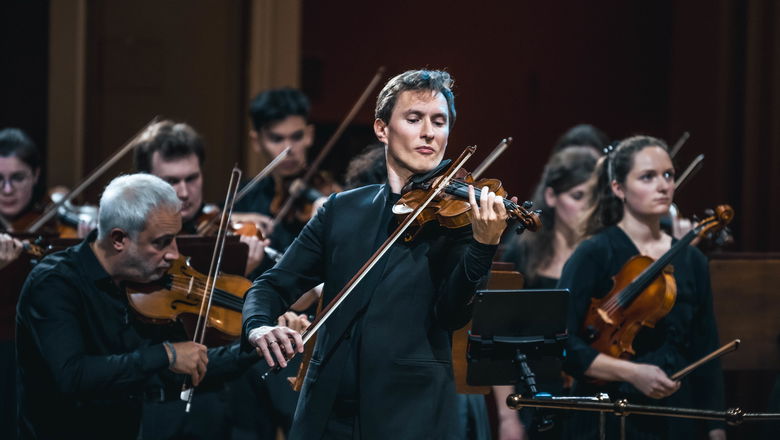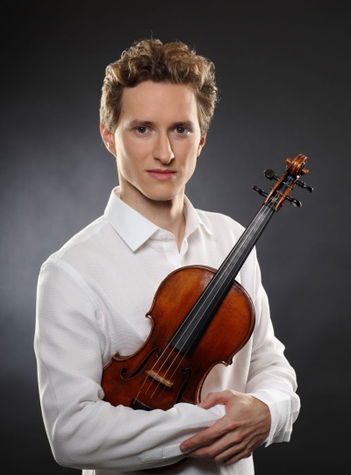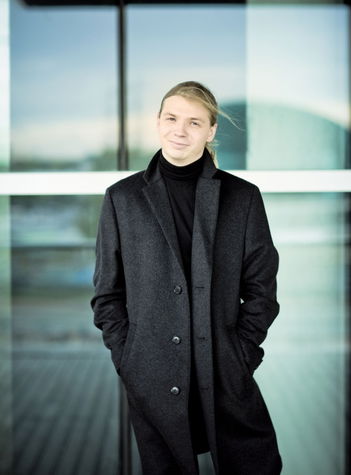1 / 6
Czech Chamber Music Society • Josef Špaček
Josef Špaček ranks among the most beloved artists of our audiences here in Prague which makes his return to the recital series a welcome occasion. Together with the brilliant pianist Denis Kozhukhin, he will offer a diverse programme spanning from Beethoven to Arvo Pärt, who celebrates his 90th birthday this year. The evening’s pinnacle will be Franck’s Sonata—an enduring gem of the violin repertoire.
Programme
Alfred Schnittke
Suite in the Old Style (16')
Ludwig van Beethoven
Violin Sonata No. 8 in G major, Op. 30, No. 3 (18')
— Intermission —
Arvo Pärt
Spiegel im Spiegel (10')
César Franck
Violin Sonata in A major, CFF 123 (29')
Performers
Josef Špaček violin
Denis Kozhukhin piano

Customer Service of Czech Philharmonic
Tel.: +420 227 059 227
E-mail: info@czechphilharmonic.cz
Customer service is available on weekdays from 9 a.m. to 6 p.m.
Performers
Josef Špaček violin, guest artist

“Working with Josef Špaček is amazing. He is a wonderful person with good heart. You can feel this in his playing, which is gracious, teeming with emotion. And his technique is marvellous. He is one of the greatest solo violinists of the present time,” says the conductor Manfred Honeck, under whom the young virtuoso has regularly given concerts, in the Czech Television documentary Devět sezón (Nine Seasons) The 2023 film provides an interesting account of Špaček’s life, also shedding light on his nine-year tenure as the Czech Philharmonic’s concert master.
Although not having been a member for several years, Josef Špaček has not ceased to collaborate with the Czech Philharmonic, pursuing numerous joint projects. And even though appearing as a soloist with celebrated orchestras worldwide and as a chamber player at the most prestigious concert venues, he continues to perform in Czech towns and remote villages.
Josef Špaček is a member of the exciting international Trio Zimbalist, giving performances all over the globe. He has regularly appeared in the Czech Republic with the cellist Tomáš Jamník and the pianist Miroslav Sekera, with whom he has created critically acclaimed albums. He has also made recordings with the Czech Philharmonic (featuring Janáček’s and Dvořák’s violin concertos, and Suk’s Fantasy), the Prague Radio Symphony Orchestra, conducted by Petr Popelka (Bohuslav Martinů’s music).
Born in 1986 in Třebíč, Bohemia, Josef Špaček showed his exceptional talent at an early age. Music was a natural part of his childhood (his father has been a cellist of the Czech Philharmonic for over three decades, and his siblings played instruments too), as described by his mother in the book Špačci ve fraku. After graduating from the Prague Conservatory
(under the tutelage of Jaroslav Foltýn), Josef went on to study in the USA, where he attended the Curtis Institute of Music in Philadelphia (his teachers included Ida Kavafian and Jaime Laredo) and The Julliard School in New York (tutored by Itzak Perlman).
After completing his formal education, he returned to his homeland, where he was named the youngest ever concert master of the Czech Philharmonic. At the same time, he performed as a soloist and chamber player, garnering international recognition. A watershed in his career was victory at the Queen Elisabeth Competition in Brussels, whereupon he began receiving invitations from the world’s most renowned institutions. Due to his having an ever more challenging and busy schedule as a musician – and to his family situation, especially following the birth of three children – he resigned from the post of concert master of the Czech Philharmonic so as to focus solely on being a soloist. Owing to his immense talent and great diligence, his childhood dream to become a famous violinist has come to pass.
Denis Kozhukhin piano

Winner of the First Prize in the 2010 Queen Elisabeth Competition in Brussels, Belgian pianist Denis Kozhukhin has established himself as one of the greatest pianists of his generation.
He has appeared with many of the leading international orchestras, such as the Chicago, London and San Francisco Symphony orchestras, Israel, London and Rotterdam Philharmonic orchestras, Royal Concertgebouw Orchestra, Staatskapelle Berlin, Philadelphia Orchestra and Philharmonia Orchestra. He is also frequently invited to play at the prominent festivals of Verbier, Gstaad, Grafenegg, Dresden, Intonations, Tsinandali, Klavier Ruhr, Lanaudiere and Jerusalem, as well as the BBC Proms.
The past season has featured collaborations with a number of European orchestras, including the return at the BBC Proms with BBC Symphony, debuts with Danish National, Gulbenkian and Indianapolis Symphony orchestras, a tour with the HR-Sinfonieorchester, a residency with the Barcelona Symphony Orchestra performing Rachmaninov’s four piano concertos, and concerts with the Oslo and Stockholm Philharmonic orchestras, the NDR Radiophilharmonie (Hannover) and WDR Sinfonieorchester (Cologne). He has appeared in recital at the Chicago Symphony Hall, Boulez Saal, Amsterdam Concertgebouw, Musikverein, Berlin Philharmonie, Frankfurt Alte Oper, Zurich Tonhalle and Bozar.
As Pentatone Artist he has released several albums, including César Franck’s Symphonic Variations with the Luxembourg Philharmonic Orchestra under Gustavo Gimeno, Mendelssohn’s Songs without Words with Grieg’s Lyric Pieces (nominated for an Opus Klassik Award), and discs of Haydn, Brahms and Prokofiev, as well as concertos by Tchaikovsky, Grieg, Ravel and Gershwin.
Kozhukhin studied at the Reina Sofía School of Music in Madrid with Dmitri Bashkirov and Claudio Martinez-Mehner, and later completed his studies at the Piano Academy at Lake Como where he received advice from Fou Ts’ong, Stanislav Ioudenitch, Peter Frankl, Boris Berman, Charles Rosen and Andreas Staier, and with Kirill Gerstein in Stuttgart.
Compositions
Alfred Schnittke
Suite in the Old Style
Tied to Russia, and yet not entirely; meditative, yet at the same time inspired by dance music; attuned the musical thinking of the past, and yet able to combine it consciously with the newer compositional currents of “polystylism”: such was Alfred Schnittke (1934–1998). A native of Engels, a town in the former Volga German Autonomous Soviet Socialist Republic, he later called himself “half German, half Jew”, living in Russia. He received his first musical training in Vienna, where his father was the editor of a German-language newspaper. After moving back to the Soviet Union (1948), Schnittke continued his studies at the Moscow Conservatoire. He converted to Catholicism in 1983, adding yet another negative to his rather unfavourable political profile besides his “infatuation with Western compositional trends”. Schnittke had difficulty advancing his career at home, but outside of Russia he had help getting performances from friends who played his works on tours or when working in long-term engagements abroad; these friends included the violinist Gidon Kremer, the conductor Gennady Rozhdestvensky, and the cellist Mstislav Rostropovich. By the mid-1980s, the West had begun to realise that Alfred Schnittke represented one of the greatest figures of Russian music since Shostakovich. In 1990, the composer received German citizenship and moved to Hamburg, where he taught at the Musikhochschule, and where he also hoped to get better healthcare. He suffered a series of strokes and struggled courageously against their consequences.
Schnittke’s Suite in the Old Style for violin and piano (1972) is one of his most popular compositions. Lyrical, listenable melodies are arranged in the form of a baroque suite in five movements. In the spirit of polystylism, Schnittke combined the musical language of the 18th century with references to works from the 19th and 20th centuries, such as Stravinsky’s Pulcinella, elaborating them with humour and carefully detailed craftsmanship. The Suite was premiered in 1973 in Moscow.
Ludwig van Beethoven
Violin Sonata No. 8 in G major, Op. 30, No. 3
There is also a remote connection between Russia and the set of three sonatas for violin and piano that Ludwig van Beethoven (1770–1827) designated as his Opus 30 and dedicated to Alexander I, the young Tsar of Russia. The composer apparently attached great importance to these sonatas, having dedicated them to such an exalted figure. According to some sources, he received an additional fee for the dedication, which was paid to him at the Congress of Vienna (1814–1815). But now we are getting ahead of ourselves. When the sonata was written (1801–1802), many of the tragic events of the Napoleonic wars had not yet taken place, and the powers who would ultimately be victorious (Prussia, Austria, and Russia) had not yet formed the Holy Alliance. For Beethoven, this was also a critical moment in his personal life. It was in 1802 that he wrote what is called the Heiligenstadt Testament, a letter to his brothers Carl and Johann that was never sent, in which he mentioned his worsening deafness and the depression arising from it, which was difficult for him to overcome.
The Violin Sonata No. 8 in G major, Op. 30, No. 3, is illustrative of how tricky it can sometimes be to comment on the circumstances of a work’s creation, or even to understand the psychology of the composer based on musical analysis. About the first movement (Allegro assai), for example, one can read that it was written with carefree humour, but also that it is full of élan, the third movement (Allegro vivace) was seen as referring to dancing in Vienna’s ballrooms, but also to the “internal struggle between life and death” then taking place within Beethoven! A more sober view of musical construction would assert that the first movement flows along in sonata form, the unusually lengthy second movement (Tempo di Minuetto, ma molto moderato e grazioso) is in ternary form, and the composer fashioned the concluding movement in the form of a rondo. In any case, the Sonata in G major and Opus 30 as a whole hold a place of importance among Beethoven’s works for violin and piano. The first edition was published in 1803 by the Bureau des Arts et de l’Industrie in Vienna.
Arvo Pärt
Spiegel im Spiegel
The name Arvo Pärt (*1935) has become synonymous with spiritual minimalism, and although he now enjoys great popularity and respect, his name is also synonymous with the humble pursuit of creativity. Pärt was born in 1935 in Estonia, which was then an independent country. Already by 1940, however, the Soviet Union had annexed Estonia, ruling it, apart from the brief episode of German occupation in the 1940s, until 1991, when Estonian independence was restored. Alfred Schnittke and Arvo Pärt were born around the same time, and their fates were simlar. Pärt studied composition in Tallin, and his early works were influenced by Neoclassicism. Later, he became familiar with dodecaphony, serialism, and other modern compositional trends. Such modes of artistic expression were out of favour with Soviet cultural officials, who expected the arts to be politically engaged, and the composer was criticised for this, as well as for his inclination towards spiritual themes. In 1972, he joined the Russian Orthodox Church. During a long creative hiatus (1968–1976), he found his own original style of “tintinnabuli”, which strove to reduce the musical material to a minimum. Under pressure from the Soviet government, he and his family emigrated to Vienna in 1980, where he obtained Austrian citizenship. Afterwards, he lived in Berlin, then in 2010 he moved back to Estonia permanently.
Spiegel im Spiegel (Mirror in the Mirror) for violin and piano was composed in 1978, and it is a typical example of Pärt’s style of tintinnabuli. The melodic line is based on scales and, indirectly, on Gregorian plainchant. The tintinnabuli voice is based on arpeggiated triads, but within the music’s strictly logically constructed “skeleton”, the beauty of each individual tone must stand out; every note has its importance, and the role of the interpreters is to release this aesthetic beauty. The title evokes the idea of infinity, constant reflection, calm, and mystery (“what is behind the mirror?”). The violinist Vladimir Spivakov and the pianist Boris Bekhterev premiered Spiegel im Spiegel in late 1978.
César Franck
Violin Sonata in A major, CFF 123
César Franck (1822–1890), a composer of German Belgian origin, lived in Paris from his youth and was known for many years primarily as a church musician and organist in several churches there, especially at St. Clotilde, and as the professor of organ and improvisation at the conservatoire. It was not widely known that besides writing music for organ, harmonium, and piano, he was composing orchestral works, operas, oratorios, and chamber music. Only during the last two decades of his life did he win recognition (Legion of Honour, president of the Société Nationale de Musique) as well as the respect of the general public for some of his late works. After the premiere of his Violin Sonata in A major, the critic Ernest Reyer remarked: “It’s not a sonata, but it’s fiendishly beautiful.” The year was 1886, the piece was a hot new sensation and doubly pleasing: Franck had dedicated it to his friend, the violinist Eugène Ysaÿe, as a wedding gift.
The cyclical Sonata in A major offers a rare balance of the tradition of classical forms, the chromatic harmony of Late Romanticism, contrapuntal erudition, and songful melody. The main theme of the first movement also appears in a variety of transformations in the other movements as the work’s “motto”. An opening prologue is followed by a contrasting second movement and a lyrical third. The final movement captivates us both for its canonic voice leading and its melodiousness. The unusual difficulty of the piano part reveals how skilled an organist (and pianist) César Franck was. Thanks to its compositional mastery, its warmth of expression, and the composer’s peculiar wisdom that an attentive listener senses in the music, the Sonata in A major has become one of the most popular compositions of its genre.